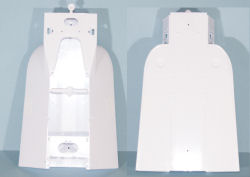
Tamiya 1/12 Martini Brabham BT44B Kit First Look
By Michael Benolkin
| Date of Review | February 2010 | Manufacturer | Tamiya |
|---|---|---|---|
| Subject | Martini Brabham BT44B | Scale | 1/12 |
| Kit Number | 12042 | Primary Media | Styrene, PE |
| Pros | Exquisite detail | Cons | Nothing noted |
| Skill Level | Intermediate | MSRP (USD) | $130.00 |
First Look
 |
 |
 |
 |
 |
 |
 |
 |
 |
 |
 |
 |
Motor Racing Developments Ltd. was a team founded by F1 World Champion Jack Brabham. In 1966, Brabham drove a Ron Tauranac-designed car to his third World Championship and his teammate Denis HHulme also won in 1967. Disappointing results thereafter led to Brabham's retirement in 1970 and Tauranac selling MRD to Bernie Ecclestone in 1971. To rejuvenate the team, Ecclestone asked Gordon Murray, who had worked under Tauranac, to design a new F1 car. Murray focused on creating a compact, lightweight, and simple design and the result was the BT42. It featured a distinctive pyramid monocoque, a DFV engine mounted directly to the aluminum chassis, and radiators mounted in the front wing for enhanced cooling performance. The orthodox suspension consisted of coil spring damper units on front outboard double wishbones and a rear 4-link setup. The rear wing was mounted as high as the rules allowed, with the airflow directed along the body toward it to create downforce.
With Carlos Reutemann and Wilson Fittipaldi at the wheel, the BT42 was entered from Round 4 Spanish GP and went on to achieve several top-10 finishes. An improved BT42, called the BT44, was entered for 1974. It has a new front suspension with anti-dive geometry that offered progressive damping effect. Other handling and aerodynamic improvements were also fitted, resulting in a competitive car which Reutermann drove to 3 victories. More changes led to the BT44B in 1975, which also saw Martini & Rossi become the main sponsor and Reutermann joined by new driver Carlos Pace. With all the ingrediants for success at the ready, the team did not disappoint and Reutermann took several podium finishes, including a win at the Brazilian GP. These strong results allowed MRD to claim 2nd place in the Constructor's Championship behind Ferrari. - Introduction from the kit instructions.
Tamiya produces some of the nicest kits on the planet and are usually very easy to build. As with any product range, some kits are better than others in detail, and you can definitely see the kits that the Tamiya engineers are really excited about. Their 1/12th scale Formula 1 race cars are one of the series of kits that are among their best.
This kit of the Brabham BT44B from the 1975 racing season is one of those kits and was originally released a number of years ago. When you look through the parts trees, the engineering is as good now as when it was first released. Tamiya has been re-releasing these kits over the past few years, one at a time, and each one has received a photo-etched upgrade.
You'll note that this kit has very few large parts. This is because Tamiya has recreated the same modules and subsystems in the car, many of which are accessible through removable body panels, similar to the full-scale racer.
This kit is molded in styrene and presented on two parts trees molded in white styrene plus separately provided cockpit shell halves, four trees of black styrene, three trees silver styrene, one tree of black vinyl plus four racing tires and a set of hoses, one tree of smoke-tinted clear styrene, one tree of chromed styrene parts, and the aforementioned photo-etched fret.
Like any high performance fighter, this kit starts its assembly off in the cockpit. The cockpit tub is this fighter recessed inside the car's fuel cell and you'll have lots of wiring and plumbing to interconnect the instruments and the various hydraulic systems in the car. The front suspension mounts to the front of the cockpit tub assembly and the car quickly starts to take form.
As with each of the cars in this series, the engine is a masterpiece of its own right. With the block assembed, mated to the transaxle housing, and painted, you'll get to wire up the ignition harness as well as the fuel injection lines. You know that in 1/12 scale, far more detail is visible than in the typical aircraft or even auto (1/24-1/25) scales, and Tamiya does not disappoint in this department. The V8 engine is detailed from its intake manifolds to the intricate exhaust headers. The ignition wiring and fuel injection plumbing are all here.
The disc brakes in the kit were nicely detailed to start with, but with the addition of the photo-etched parts, you'll definitely have something nice to look at when you do pull one of the wheels off an axle. These photo-etched parts add additional fidelity over the original issue with disc brake surfaces, intricately detailed quick-release safety harness, and radiator grilles nicely rendered.
Speaking of details, the kit does feature working suspension, steerable front wheels, and the removable cowl panels mentioned above to show off the detail inside the car.
In this release, three cars are rendered here:
- No.7 Carlos Reutermann, Brazilian GP, 1975
- No.8 Carlos Pace, Brazilian GP, 1975
- No.7 Carlos Reutermann, German GP, 1975
- No.8 Carlos Pace, German GP, 1975
This kit represents a major step in the evolution of Formula 1 racing and if you 'feel the need for speed', this is one car that should be on your short-list of hot projects.
My sincere thanks to HobbyLink Japan for this review sample!







